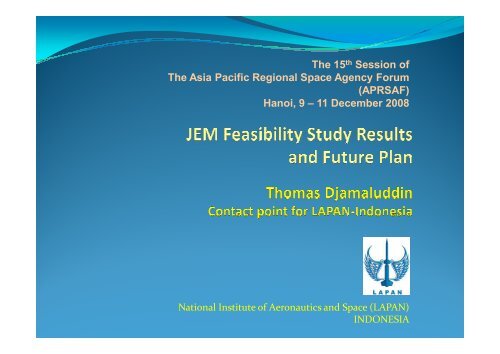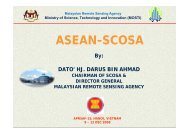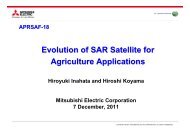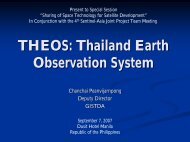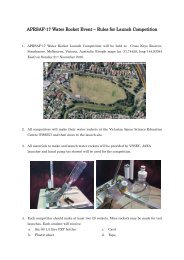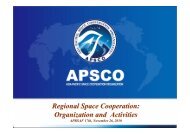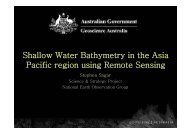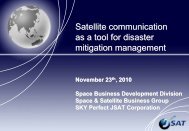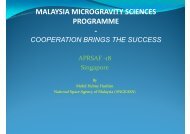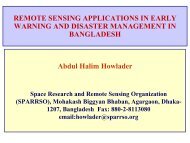Activity report from Indonesia - APRSAF
Activity report from Indonesia - APRSAF
Activity report from Indonesia - APRSAF
You also want an ePaper? Increase the reach of your titles
YUMPU automatically turns print PDFs into web optimized ePapers that Google loves.
The 15 th Session of<br />
The Asia Pacific Regional Space Agency Forum<br />
(<strong>APRSAF</strong>)<br />
Hanoi, 9 – 11 December 2008<br />
National Institute of Aeronautics and Space (LAPAN)<br />
INDONESIA
Feasibility Study Report<br />
Banana Experiment<br />
by Dr. Fenny Dwivany, et al. (ITB)
Proposed Joint Research on JEM<br />
Dr. Fenny M. Dwivany of SITH-ITB propose research on “The effect of a<br />
space environment on the expression of fruit ripening associated<br />
genes”<br />
Hypothesis: Factor that induce fruit ripening: Autocatalytic process<br />
when ethylene is produced by fruit itself or produced by other sources<br />
in the space environment that can induce fruit ripening.<br />
Hypothesis: Factors that inhibit fruit ripening: Compared to conditions<br />
on the earth at l g, lack of convective mixing in space may cause large<br />
boundary layers of O 2 and CO 2 , at different levels, to surrounding plant<br />
organs. Elevated CO 2 level can reduce ethylene whilst reduced O 2 level<br />
can reduce ethylene synthesis.<br />
However, whether environmental condition during experiment in<br />
KIBO will change the ACS and ACO gene expression profile and<br />
resulting in inhibition or enhancement of fruit ripening still need to be<br />
studied.
Feasibility Study<br />
Experiment done in Tsukuba Space Center of JAXA<br />
(Japan) and in ITB (<strong>Indonesia</strong>), January 2008<br />
Dr. Fenny Dwivany (PI), Dr. Rizkita R. Esyanti, and Ms.<br />
Listya U. Karmawan
EXPERIMENT SCHEDULE AT JAXA<br />
DATE ACTIVITY EQUIPMENT CONSUMABLES<br />
14 January 2008 Samples handling<br />
Lab inspection, clinostat and incubator setting, starting experiment using<br />
clinostat,<br />
Incubator<br />
15 January 2008 Ethylene treatment for Japan’s banana Incubator Etephon<br />
16 January 2008 as above<br />
17 January 2008 1. Put banana in centrifuge<br />
2. Take data/sample as day-0 for clinostat using Chiquita banana (sample<br />
code: ACli, ACt)<br />
Centrifuge<br />
Clinostat<br />
Liquid nitrogen<br />
Plastic/aluminium foil<br />
18 January 2008 1. Take data/sample for centrifuge (control, vertical g, horizontal g)<br />
(photo, isolation of banana finger)<br />
2. Put Sunpride Cavendish banana in clinostat (was not used as day-0<br />
sample)<br />
Centrifuge<br />
Clinostat and incubator<br />
Freezer -80 o C<br />
Liquid nitrogen<br />
Plastic/aluminium foil<br />
19 January 2008 1.Take data/sample as day-1 for clinostat using Sunpride Cavendish<br />
banana (sample code: Bcli1, BCt1)<br />
(photo, isolation of banana finger)<br />
2.RNA extraction solution preparation<br />
Clinostat and incubator<br />
Freezer -80 o C<br />
Laboratory glass ware*<br />
Liquid nitrogen<br />
Plastic/aluminium foil<br />
20 January 2008 1.Take data/sample as day-2 for clinostat Sunpride Cavendish banana<br />
(sample code: BCli2, BCt2)<br />
(photo, isolation of banana finger)<br />
Clinostat and incubator,<br />
Freezer -80 o C<br />
Liquid nitrogen<br />
Plastic/aluminium foil<br />
21 January 2008 1.Take data/sample as day-3 for clinostat Sunpride Cavendish banana<br />
(sample code: BCli3, BCt3)<br />
(photo, banana finger);<br />
2. RNA extraction <strong>from</strong> all samples<br />
Clinostat and incubator,<br />
Freezer -80 o C<br />
RNA extraction equipment*<br />
Liquid nitrogen<br />
Plastic/aluminium foil<br />
Chemicals for RNA extraction
Banana samples:<br />
Banana <strong>from</strong> <strong>Indonesia</strong>: The green mature bananas have<br />
been treated with ethylene gas for 24 hr at 14 o C. After<br />
ethylene treatment, the fruits were then sealed with<br />
plastics bag and vacuumed. It takes about 24 hr after sealed<br />
with plastics bag to arrive at JAXA on 14 Jan 08. Banana<br />
fruits were then stored at 14 o C incubator until experiment<br />
was started on 16 Jan 08.<br />
Banana <strong>from</strong> Japan: The bananas were stored at 14 o C<br />
incubator until 15 Jan 08 and treated with ethephon.<br />
Ethephon treatment was performed 24 hr at 14 o C until<br />
experiment was started on 16 Jan 08.
Experiments<br />
Two experiments were performed: using clinostat and centrifuge. The<br />
control was conducted without any treatment.<br />
Clinostat<br />
The room for Clinostat was set at 25 o C. Bananas were placed on<br />
styrofoam box and rotated at clinostat for one day (Chiquita banana<br />
<strong>from</strong> Japan/Philippines) and for three days (Sunpride Cavendish<br />
banana <strong>from</strong> <strong>Indonesia</strong>). Two banana fingers were collected everyday<br />
for sunpride (at day1, day 2 and day 3), whilst Chiquita only at day 0<br />
Centrifuge<br />
Centrifuge was set at 19-20 o C, 45-50 % humidity and acceleration 49<br />
m/sec or 5 g. Total 6-8 bananas (Chiquita banana) were placed on<br />
centrifuge chamber for one day. The treatments were vertical gravity,<br />
horizontal gravity, and control.
Experiments<br />
Gas sampling<br />
Sampling of gas was performed<br />
by placing one finger of banana<br />
<strong>from</strong> each time point into glass<br />
jar for 1 hr. The gas was then<br />
collected using syringe. The<br />
collected gas was measured for<br />
O 2 and CO 2 content (ethylene<br />
content was determined later).<br />
Sampling of gasses <strong>from</strong> the glass jar.
Observation<br />
Observation was made visually and using digital camera.<br />
The color of banana fruits <strong>from</strong> day 1 to day 3 showed a gradual change<br />
<strong>from</strong> green to yellow (data not shown).<br />
Interestingly, each banana fruit treated in clinostat showed a sudden<br />
increase of respiration when observed for 1 hour inside the gas chamber.<br />
It was shown by the presence of more water vapor on the wall of the jar<br />
compare to that in the control . Increase in respiration will lead to the<br />
synthesis of more ethylene (auto catalytic), which will then expected to<br />
cause an earlier maturation process compare to that in the control.<br />
Sample treated in centrifuge was not observed for gas generation.<br />
However, in the future, gas observation for this treatment should also<br />
be conducted.
Observation: Day 1<br />
A<br />
B<br />
Sunpride Cavendish Banana sample at day 1, after clinostat treatment for 16 hr<br />
A. control (BCt1) B. treatment (BCli1)
Observation: Day 2<br />
A<br />
B<br />
Water vapor<br />
Sunpride Cavendish Banana sample at day 2, after clinostat treatment for 16 hr<br />
A. control (BCt2) B. treatment (BCli2)
Observation: Day 3<br />
A<br />
B<br />
Water vapor<br />
Sunpride Cavendish Banana sample at day 3, after clinostat treatment for 16 hour<br />
A. control (BCt3) B. treatment (BCli3)
Sample isolation and RNA extraction<br />
Banana fingers were collected and cut into small cubes.<br />
Immediately after cut, cubes were frozen in liquid nitrogen<br />
and placed in -80 o C freezer. Samples were then proceed for<br />
RNA isolation until step 8 (LiCl incubation at 4 o C) and<br />
transported to Indonesa.<br />
The samples were then proceed immediately after arrive in<br />
<strong>Indonesia</strong> (stored for about 7 hr in 4 o C after arrive, 0.30 am-<br />
7.30 am). The RNA extraction was finished on 24 Jan 08.<br />
The quality of RNA was analyzed using spectrophotometer<br />
and agarose gel. However, the ratios of A260/280 were around<br />
1.0. In addition, electrophoresis result showed that RNA <strong>from</strong><br />
sample was degraded. Next time, RNA isolation should be<br />
finished on site to minimize RNA degradation
Experiment at ITB<br />
25S rRNA<br />
18S rRNA<br />
Banana fruit ripening process (day 0-day 6)<br />
RNA isolation <strong>from</strong> banana pulp during fruit<br />
ripening (day 1-day 7).
Experiment at ITB<br />
(A)<br />
200 bp<br />
(B)<br />
100 bp<br />
400 bp<br />
Electroferogram of RT-PCR results using the MaACO1 and MaACS1 gene specific<br />
primers and three reference genes. The samples were <strong>from</strong> ripening banana’s pulp<br />
which were harvested on day 1, day, 3, day 5 and day 7. (A) 1-4 (MaACS1 primer) and<br />
(B) 1-4 (MaACO primer), 5-8 (Ma18S rRNA primer), L (100 bp DNA ladder), 9-12<br />
(MaActin primer), 13-16 (MaGAPDH primer).
Experiment at ITB<br />
Figure 3.4 Normalized MaACS and MaACO genes fold expression
Experiment at ITB<br />
CO 2<br />
production and CO 2<br />
consumption during experiment
ISS Kids in Bahasa <strong>Indonesia</strong>
Future Plan
Banana Experiment<br />
It should be considered whether a longer experiment can be<br />
performed using centrifuge in various g forces in the future.<br />
Clinostat experiment should be performed at least for 2-7 days<br />
in the future<br />
Sample treated in centrifuge was not observed for gas generation.<br />
However, in the future, gas observation for this treatment should<br />
also be conducted.<br />
Video camera is needed to observe the formation of water vapor<br />
on the wall the glass jar<br />
A more practical, yet accurate, methods to measure fluctuation<br />
of gasses (O2, CO2, and ethylene) during observation are needed<br />
(such as probes connected to digital gas analyzer).<br />
Next time, RNA isolation should be finished on site to minimize<br />
RNA degradation
External payload utilization<br />
Potential research field: SEDA, MAXI,<br />
SMILES<br />
Cooperative researches using KIBO EF<br />
will be promoted in each research<br />
community.<br />
JAXA inform how to access each<br />
research team.
Proposed Joint Research:<br />
Solar Activities Influence<br />
on Space Environment<br />
in Satellite Orbit
Proposed Joint Research:<br />
JEM Meteoroid Detection compared to<br />
Meteor Wind Radar Detection
14000<br />
Meteor Flux per Day<br />
12000<br />
10000<br />
8000<br />
6000<br />
4000<br />
2000<br />
0<br />
2002.8 2003 2003.3 2003.5 2003.8 2004 2004.3 2004.5 2004.8 2005 2005.3 2005.5 2005.8 2006 2006.3 2006.5 2006.8 2007<br />
Year<br />
Blue: Meteor Flux Red: Model of flux based on ecliptic and solar activity variation)<br />
Meteor Wind Radar at Kototabang, <strong>Indonesia</strong><br />
From MWR detection,<br />
there is an indication<br />
that meteor influx<br />
depend solar activity.<br />
Is that Interplanetary<br />
variation or<br />
atmospheric variation
That is all....<br />
Thank you


